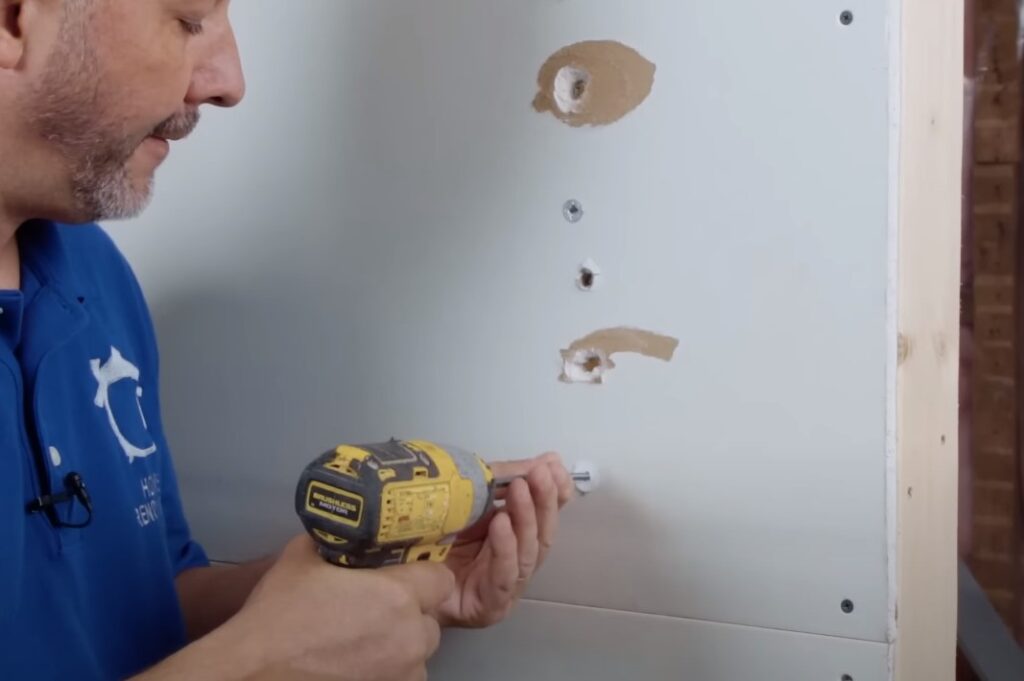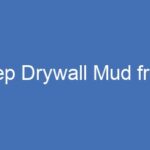You might be moving into a new house and notice a drywall screw pop on the wall. Alternatively, the old house you’ve lived in for 40 years might have a fresh screw pop you’ve just noticed last week.
There’s no need to panic. Drywall screw pops can be easily fixed. But first, it’s essential to grasp why they occur.
Understanding the Causes of Drywall Screw Pops
Several factors can lead to drywall screws popping, often due to a combination of reasons resulting in an unexpected blemish on your wall. The good news is that these issues are typically not serious and can be repaired easily.
But what leads to screws popping through drywall?
- Using incorrect length drywall screws.
- Driving drywall screws or fasteners too deep.
- Not using an adequate number of screws or fasteners in the wallboard.
- House or building foundation settling.
- Studs drying out from high moisture content or humidity.
- Drywall or sheetrock drying out from moisture or humidity.
- Drywall screws or nails improperly spaced.
- Drywall screws or nails driven in at an angle rather than straight.
Are Drywall Screw Pops Cause for Concern?
Usually, the age of the building is the culprit behind drywall screw pops. Over the years, buildings shift slightly, expand, contract, heat, and cool.
All these minor fluctuations in temperature and humidity cause wood to expand and contract slightly. Additionally, building foundations tend to settle and shift over many years.
Drywall nails and screws can pop out with even the slightest movement.
Unless dozens of screw heads and nail pops suddenly appear all over your walls and ceiling, screw pops are nothing to worry about.
They can be easily fixed in just a few minutes, and with only a few dollars’ worth of tools, fasteners, and supplies.



Drywall Nail Pops
Are screw and nail pops common? They can occur in new homes as well as older homes.
Nail pops are most common in older homes. Back in the ‘old days,’ drywall was fastened with hammers and nails rather than power drills and drywall screws.
Wood Studs Expand and Contract
Drywall nails tend to give way and loosen in wood studs. Wood framing expands and shrinks or contracts as hot temperatures change to cold temperatures. Over several seasons and years, drywall nail pops can easily occur.
Wood studs lose their grip on drywall nails over time, causing nails to push through the smoothly painted surface of a wall.
Completely Remove the Drywall Fastener
You can’t simply pound the nail back in with a hammer. The damage has been done. The best way to fix a nail pop is to completely remove the nail or fastener.
It might seem like you’re making unnecessary mess by destroying the drywall surrounding a nail pop, but in the long run, it’s the only way to properly address the problem.
How to Repair Drywall Screw Pops
It can be disappointing to notice a fresh drywall screw pop on your wall or ceiling. Is my entire house shifting and busting loose? Probably not.
A drywall screw and nail pop is usually nothing to panic over. You can easily handle the drywall repair on your own. It’s one of the easiest DIY projects you will find.
If you know a few basic tips, drywall screw and nail pops are easily repairable within just a few minutes.
Here are a few tools you’ll need before you begin repairs:
- Drywall screw fasteners
- Safety glasses
- Cordless drill, screw gun, or screwdriver
- Smooth head hammer
- 6″ or 4″ drywall taping knife, or putty knife
- Drywall joint compound or spackle
- Utility knife or drywall knife
- Fine grit sandpaper
Simple Steps to Repair Drywall Screw Pops
Now that you’re ready to begin, you’re just a few simple steps away from a smooth wall:
- Cut the drywall around the surrounding area of the screw hole, nail, or screw pop.
- Pound the nail gently back into the wood stud, or remove the nail if possible.
- If it’s a screw pop, reverse the screw out of the wall with a cordless drill.
- Add a new drywall screw above and below the screw pop, directly into the center of the stud.
- Smooth joint compound over the entire damaged area.
- Allow drying time for the drywall mud. A second coat of drywall compound may be necessary due to shrinkage.
- Sand the area lightly and prepare for new paint. One more home improvement project is nearly complete.
How to Prevent Drywall Screw Pops
For anyone hanging new drywall, there are a few simple rules to follow for future drywall screw pop prevention.
- Be sure you are driving in drywall screws to a proper screw depth. The head of the screw should rest just slightly below the drywall surface, without breaking through the drywall paper.
- Don’t use too many screws. Too many drywall screws won’t help strengthen your wall, and it won’t prevent screw pops. Use the recommended screw spacing required for the wall assembly–no more, and no less.
- Pay attention to moisture and humidity. You want to be fastening drywall at typical temperature and humidity levels. When the drywall panel is installed on wood that has soaked up moisture, the wood slowly dries out after the drywall is hung. There will be slight movement in the stud. It doesn’t matter if it’s a new screw or old, it could pop.
Drywall Screw Pops in the Ceiling
Fixing drywall screw pops in the ceiling is essentially the same process as on the walls.
One thing to keep in mind is to add drywall fasteners on each side of the screw pop and be sure they are securing the drywall tightly to the roof truss or soffit framing.
If you have textured ceilings, there will be an extra step involved with matching the texture. But by keeping the repair area as small as possible, you’ll have less texture to match.
Not a professional drywall contractor or expert taper? Don’t worry; with a little information, even beginner DIYers and the newest homeowners can take on a ceiling screw pop repair of almost any kind.
Preventing Drywall Screw Pops
A few tips during construction will prevent drywall screw pops from ever occurring:
- Use kiln-dried lumber framing material. Most quality lumber yards follow this procedure, but it’s a good reminder to ask if the lumber has been properly dried.
- Be sure drywall installation occurs during proper levels of humidity. Even gypsum drywall will absorb moisture. When it slowly dries out, contraction will occur. There are certain types of drywall that can resist moisture better than others. Discuss your product options for the best results.
Spotting Drywall Screw Pops Under Paint
If you’re unsure how to detect a drywall screw pop, here are a few additional tips. Do you see bumps in your wallboard, especially in certain high natural light areas? Most likely, those bumps are screw or nail pops ready to poke through the wall.
Repairing a few nail pops can be a simple job. Remove the screw, add spackling compound, do a little light sanding, and touch up the paint. That’s it. With a bit of experience and practice with the application of drywall mud, you’ll be ready to tackle any drywall pop.
tag: # Repair Drywall Screw Pops







